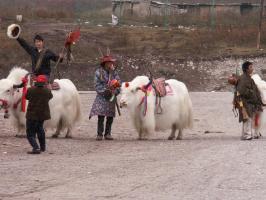Largest Building of Shang Dynasty in Sanxingdui,Sichuan
With the excavation of archeological team, a large rectangular house appeared in Sanxingdui. How large is it? What kind of architecture is it? The discovery of it triggered a series of questions. On Jan 15, the results report meeting on Sanxingdui Qingguanshan large building foundation was held in Guanghan. Experts from Sichuan and other provinces discussed issues concerning this special house. They concluded that this building is so far the second largest Shang Dynasty single building foundation discovered and is the largest in south China. The largest one is the No.1 palace site north main hall of Huanbei Shang city in Anyang City.
This time’s excavation was carried out in the north and southeast of Sanxingdui within an area of 3.25-sq.km. One rammed earth platform base group of Sanxingdui period as well as 41 tombs, 13 kiln sites, 140 ash pits and 27 cultural accumulations of various periods were found. One breakthrough is that two new rammed earth walls of Sanxingdui period were preliminarily confirmed and several ancient waterways were discovered in the site.
Under the guide of Lei Yu, director of Sanxingdui Workstation of Sichuan Cultural Relics and Archeology Research Institute, reporters arrived at the excavation spot. There are two long straight lines which are actually red burnt earth with cobbles. “This is the foundation of the building,” said Lei Yu. Looking from the surface, the building is rectangular. It is about 55-meter long and 15-meter wide and the area amounts to nearly 900-sq.m.
There are gateways in both east and west sides of the building and there are some pillar holes in the middle of the house. It is estimated that the building consists of six to eight main halls which are arranged in two rows and are symmetric along the central corridor. Each main hall is about six to eight meters wide and three meters deep. The central corridor is about five-meter wide.
Reporters saw that there is one row of rectangular pits inside and outside of the wall footing. Some are covered by plastic cloth. Lei Yu said that some rotten ivory and broken jade were discovered here when the surface earth was removed. Excavation of those objects hasn’t yet been conducted. There are nearly 200 such pits whose foundations are laid with red burnt soil blocks with large quantities of cobbles. Experts estimate that those pits may be “eave columns”. There is a one-meter wide corridor between two rows of “eave columns”.
Then, how high is the standard of this building and what is it used for?
Zhao Dianzeng, researcher of Sichuan Cultural Relics and Archeology Research Institute, pointed out that this large building is situated in northwest-southeast direction which accords with the direction of Sanxingdui site and No.1 and No.2 sacrificial pits. According to previous study, Sanxingdui differs from common ancient capital cities in that it is related to primitive sacrifice and religious faith. As a result, this building is likely to be a match of sacrificial pits and is a place for displaying the sacrifice. “It seems that this building is not used for dwelling,” said Lin Xiang, professor of the Department of Archaeology, Sichuan University. Located in the northwest corner of the ancient town, it is more like a ceremonial building which is relevant to ancestral or religious temple.
Liu Xu, professor of the School of Archaeology and Museology, Peking University, posed a different view. He stated that this rectangular building has doors on both ends but not on both sides and there is a corridor in the middle. This structure is different from palace or residential buildings. It is more like an imperial storage. Imperial storages of Shang and Zhou period have been discovered in other places in China. Moreover, they are all near the edge of the city and are close to the walls. In Liu’s opinion, this building probably is one large warehouse in Sanxingdui.
Though the use of this building hasn’t been decided yet, experts agree that no matter it is ancestral temple, palace or imperial warehouse, only the imperator at that time can use it. Because its foundation is red burnt soil, which is solid and moisture-proof, showing that it is of high standard.














